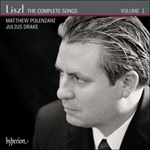The
Tre sonetti di Petrarca were the direct result of Liszt’s sojourn in Italy during 1838–9; we learn that he and Marie d’Agoult read Petrarch and Dante together. The origins of the poetry are legendary: on Good Friday, 6 April, 1327, the great fourteenth-century poet Petrarch saw a woman named Laura in the church of Sainte-Claire d’Avignon, and his passion for her is celebrated in the 366 poems of his
Rime sparse (Scattered rhymes, later known as
Il Canzoniere / The Songbook). The songs—arias in all but name—exist in both a pre-Weimar version for tenor and a later revision for mezzo-soprano or baritone; we hear the virtuosic first version on this disc. The first sonnet, ‘Pace non trovo’, is packed with Petrarch’s characteristic oxymorons, antitheses, and dichotomies (staring without eyes, crying without voice, burning and freezing alike) that bespeak the paradoxes of love. For such imagery, Liszt begins with an agitated succession of his most advanced harmonies followed by extreme contrasts between dramatic-operatic outbursts and ecstatic lyricism, twice bidding the tenor reach for the D flat above high C. In ‘Benedetto sia ’l giorno’, Petrarch calls for multiple blessings on his first sight of Laura, his love for her, and his own thoughts and verses about her. Liszt moves from key to key, benediction to benediction, in his trademark restless, innovative way. ‘I’ vidi in terra angelici costumi’ tells of heavenly angels on earth and earth-shattering beauty in the person of Laura, whose harmonious being fills the air with sweetness. This celestial song, with its breathtaking harmonic shift just before the invocation of ‘Love! wisdom! valour, pity and grief’, ends quietly and reverently.
from notes by Susan Youens © 2010
Les
Tre sonetti di Petrarca ont été le résultat direct du séjour de Liszt en Italie en 1838–1839; on sait que Liszt et Marie d’Agoult lisaient ensemble Pétrarque et Dante. Les origines de la poésie sont légendaires: le Vendredi saint, 6 avril 1327, le grand poète du XIVe siècle Pétrarque a vu une femme nommée Laura dans l’église Sainte-Claire d’Avignon et sa passion pour elle est célébrée dans les 366 poèmes de ses
Rimes éparses (connues par la suite sous le titre
Il Canzoniere). Les mélodies—en fait des arias qui n’en ont pas le titre—existent dans une version pour ténor antérieure à l’époque de Weimar ainsi que dans une version ultérieure pour mezzo-soprano ou baryton; dans ce disque, c’est la première version virtuose qui est enregistrée. Le premier sonnet, «Pace non trovo», regorge des oxymorons, antithèses et dichotomies caractéristiques de Pétrarque (regardant sans les yeux, criant sans voix, brûlant et gelant à la fois) qui témoignent des paradoxes de l’amour. Pour de telles images, Liszt commence par une succession agitée de ses harmonies les plus avancées suivie de contrastes extrêmes entre des éclats lyrico-dramatiques et un lyrisme extatique, Liszt demandant par deux fois au ténor d’atteindre le ré bémol au-dessus du do aigu. Dans «Benedetto sia ’l giorno», Pétrarque bénit le jour où il a vu Laura pour la première fois, son amour pour elle, ses propres pensées et les vers qu’il a écrits à son sujet. Liszt passe d’une tonalité à une autre, d’une bénédiction à une autre, dans ce style novateur et agité qui le caractérise. «I’ vidi in terra angelici costumi» parle d’anges divins sur terre et de beauté bouleversante en la personne de Laura, dont l’être harmonieux remplit l’air de douceur. Ce chant céleste, avec ses changements harmoniques stupéfiants juste avant l’invocation de «L’amour, la raison, le courage, la pitié et le chagrin» s’achève dans le calme et le respect.
extrait des notes rédigées par Susan Youens © 2010
Français: Marie-Stella Pâris
Die
Tre sonetti di Petrarca waren das unmittelbare Ergebnis von Liszts Italienaufenthalt der Jahre 1838/39, wo er zusammen mit Marie d’Agoult Petrarcha und Dante las. Das Gedicht ist legendären Ursprungs: Am Karfreitag, dem 6. April 1327, erblickt Petrarcha, der große Dichter des 14. Jahrhunderts, in der Kirche von Sainte-Claire d’Avignon eine Frau namens Laura und setzt seiner Leidenschaft für sie ein Denkmal mit den 366 Gedichten seines Zyklus
Il Canzoniere. Liszts Vertonungen, die man sehr wohl als Arien bezeichnen könnte, sind als Versionen für Tenor aus der Zeit vor Weimar und für Mezzosopran oder Bariton aus späterer Zeit überliefert; hier ist die virtuose erste Fassung eingespielt. Das erste Sonett mit dem Titel „Pace non trovo“ steckt voller für Petrarcha typischer Widersprüche, Antithesen und Dichotomien (blickloses Starren, stimmloses Schreien, brennende Kälte) zur Beschreibung verliebter Gefühlswallungen. Liszt verarbeitet diese Bildhaftigkeit, indem er mit einer aufgewühlten Abfolge seiner höchstentwickelten Harmonien beginnt, denen extreme Kontraste von opernhaft dramatischen Ausbrüchen und lyrischer Ekstase folgen. Zweimal erwartet Liszt vom Tenor, das Des über dem hohen C zu erreichen. In „Benedetto sia ’l giorno“ beschwört Petrarcha die mehrfache Segnung seiner ersten Begegnung mit Laura, seiner Liebe zu ihr und seiner Gedanken und Verse über sie. Liszt wechselt von einer Tonart zur nächsten, von Segnung zu Segnung, in der ihm eigenen ruhelosen, innovativen Weise. „I’ vidi in terra angelici costumi“ erzählt von himmlischen Engeln auf Erden und erderschütternder Schönheit in der Gestalt von Laura, deren harmonisches Wesen die Lüfte versüßt. Dieses himmlische Lied mit seiner atemberaubenden harmonischen Verschiebung unmittelbar vor der Anrufung von „Liebe, Vernunft, Mut, Mitleid und Gram“ endet ruhig und ergeben.
aus dem Begleittext von Susan Youens © 2010
Deutsch: Henning Weber


 Liszt: Liszt Abroad
Liszt: Liszt Abroad BBC Music Magazine
BBC Music Magazine Liszt: The Complete Songs, Vol. 1 - Matthew Polenzani
Liszt: The Complete Songs, Vol. 1 - Matthew Polenzani
